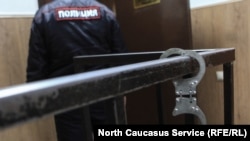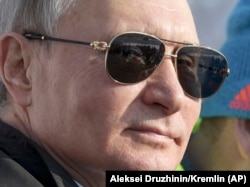On March 17, 2019, Forbes contributor Ariel Cohen appeared on Russian state television’s “Evening with Vladimir Solovyov” program to discuss the so-called Vladimir Putin Transparency Act (H. R. 1404), which passed in the U.S. House of Representatives on March 12, and other issues related to U.S. efforts to counter corruption in Russia.
That bill seeks to “strengthen the United States response to Russian interference by providing transparency on the corruption of Russian President Vladimir Putin.”
This prompted Solovyov to turn his attention to graft in the United States, asking how many high-ranking American officials would “suffer” if the U.S. “suddenly begins to actually start fighting corruption.”
Cohen, who also is a senior fellow at the Atlantic Counicil, replied that he supports fighting corruption everywhere. He added that Russia’s law enforcement practices and institutions are not yet considered transparent enough by the world community to take part in broader transparency efforts.
“We know about telephone justice. We know about judges getting their verdicts dictated. We know about the politicization of legal actions,” Cohen said, adding that that was why the U.S. only cooperated with certain states on anti-graft measures.
Regarding telephone justice – the practice of powerful individuals calling judges to instruct them on what verdicts to deliver – Solovyov claimed “it used to be like that” in Russia, adding the present situation needed to be assessed in detail.
“… If we study the percentage of verdicts and serious cases, we’ll discover that it’s not an accident that Russia has the lowest prison population in the entire history of our state, 400,000 people or something like that. America has the highest, by the way.”
What to make of this?
First, Solovyov’s claim that Russia’s falling incarceration rate demonstrates that telephone justice has gone by the wayside is unsubstantiated. A 2014 U.N. Human Rights Council Report on the challenges to the independence and impartiality of the Russian judiciary stated the following:
“The worrisome perception that judges already know what they are going to decide before proceedings are completed is reinforced by the frequent lack of justification for verdicts rendered, including decisions on pretrial detention.”
That perception is reinforced by the fact that Russia’s acquittal rate in 2017 was only .34 percent in 2017. While the degree and scope of telephone justice remains unclear, a falling incarceration rate in itself does not demonstrate the impartiality with which verdicts have been reached.
As for Solovyov’s claims regarding Russia’s record low number of prisoners versus the United States’ world-leading incarceration level, on a strictly quantitative level, that appears to be correct.
According to the Estonia-based news portal Meduza and other Russian media outlets, Russia’s Federal Penitentiary Service (FSIN) reported in December 2018 that 467,724 people were incarcerated in the country (compared with 588,000 people in January 2013 and 497,000 in January 2018) – apparently the lowest level in the history of the modern Russian state.
Late last year, 14,000 people were released due to a change in the way Russia calculates days spent in pre-trial detention, with 100,000 more facing early parole.
The FSIN reported that as of March 1, 455,514 people were serving their sentences in correctional colonies in Russia and 100,771 people were being held in pre-trial detention.
Including the Crimean peninsula, Russia’s official population is 146,781,000. Based on the FSIN’s latest data, Russia roughly incarcerates 310 people per 100,000 residents of all ages.
What about the United States?
While the U.S. Department of Justice released a study in 2016 saying the incarceration rate was at its lowest rate since 1996, at that time the government said there were still 2,162,400 people behind bars.
With 670 people per 100,000 in prison or local jail for that year (the Statista portal put the figure at 655 prisoners per 100,000 in July 2018), the U.S. is estimated to have both the highest per capita incarceration rate and the largest prison population in the world. There is considerable debate in the U.S. on the reasons for this stark number and proposals for change in the criminal justice system.
We find that judging by the numbers alone does not paint a complete picture of a criminal justice system. The right to due process, the likelihood of experiencing human rights violations (as well as the severity of related acts) and determining how many people are actually incarcerated are drastically complicated in nations that are less transparent.
China and North Korea come to mind, in terms of lacking overall transparency in their prison populations. Russia’s problematic record in its criminal justice system, including illegal detention and sporadic killing of gay men in Chechnya, unexplained disappearances in the North Caucuses and “law enforcement personnel engaged in torture, abuse, and violence to coerce confessions from suspects” raise troubling questions that are not the focus of this fact check.
But on purely quantitative basis, Solovyov’s claims regarding Russia’s falling incarceration rate and the United States disproportionately high incarceration rates are true, although the connection between that and the existence of telephone justice is not established.
Polygraph.info therefore finds Solovyov’s overall claim to be unclear.








